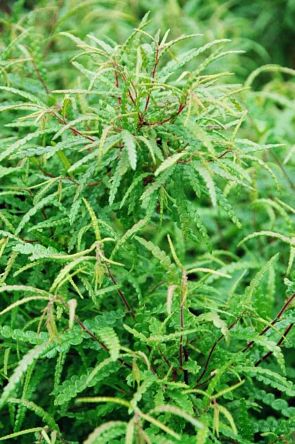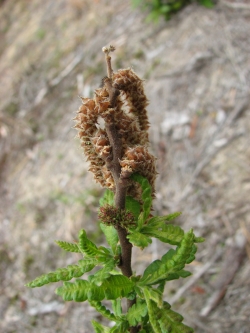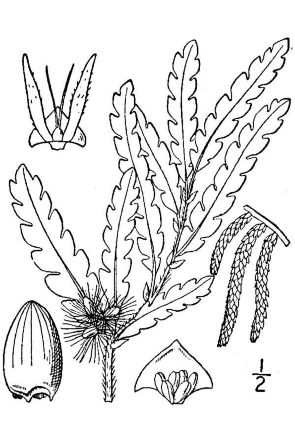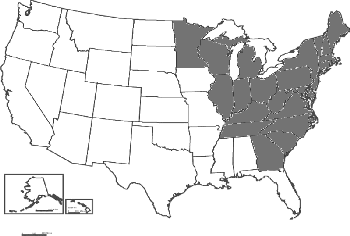Comptonia peregrina
 |
 |
 |
| Photos courtesy Renee Brecht |
Britton & Brown |
|
| Botanical name: | Comptonia peregrina (L.) Coult. |
| Common name: | sweet fern |
| Synonomy: | Comptonia peregrina (L.) Coult. var. aspleniifolia (L.) Fern. Myrica aspleniifolia L. Myrica aspleniifolia L. var. tomentosa (Chev.) Gleason Myrica peregrina (L.) Kuntze |
| Group: | dicot |
| Family: | Myricaceae |
| Growth type: | shrub, subshrub |
| Duration: | perennial |
| Origin: | native |
| Plant height: | 1 - 4.5' |
| Foliage: | Fragrant, pubescent. Alternate, simple leaves, resembling fern (hence the name) that are 2.5-4.7" long on red-brown to gray woody stems |
| Flower: | brown catkins clustered at the ends of branches, 1.2-1.6" long. May be monecious or dioecious. |
| Flowering time: | March - April |
| Habitat: | Dry, sterile, sandy to rocky soils in pinelands or pine barrens, clearings, or edges of woodlots |
| Range in New Jersey: | statewide |
| Heritage ranking, if any: | n/a |
| Distribution: |  |
| Misc. | Sweetfern fruits are eaten by
flickers, white tailed deer, and it has limited use as food and cover
for cottontail rabbits and ruffed grouse. Comptonia, after Henry Compton, Bishop of London from 1632-1713, by Sir Josiah Banks, peregrina, from the Latin, "foreign" A colonizer species, follows fire in open canopy. Fire Effects Information System (FEIS) Eflora.org reports that it has been variously used by "many Native American tribes used different parts of Comptonia peregrina variously: as an incense for ritual ceremonies; for medicinal purposes; as a stimulant or tonic; as a food seasoning; and as a poison (D. A. Moerman 1986)." |